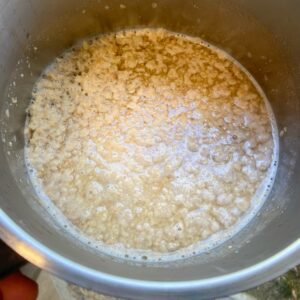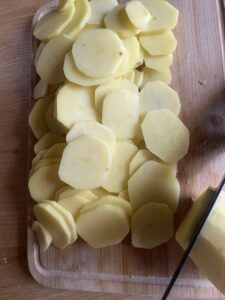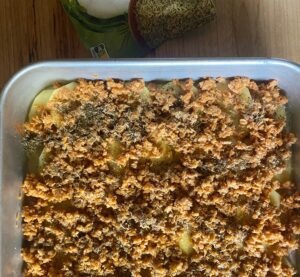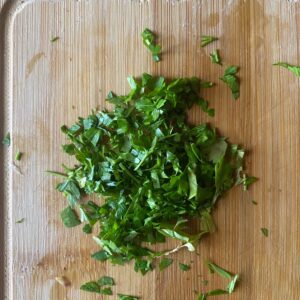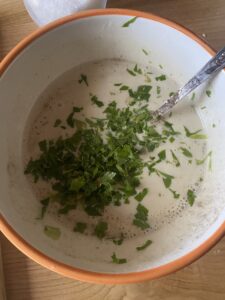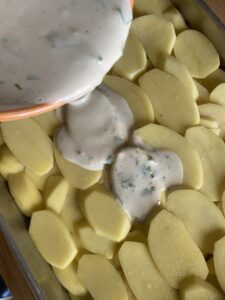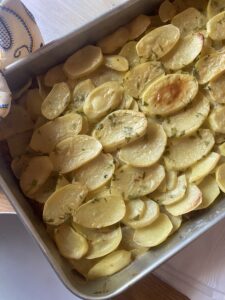Mussaka sa Krompirom – Serbian potato oven dish (vegan)

Inspired by what arises from inside me, I dedicate this week to an exploration of vegan food from former Yugoslavia.
Cuisine from the former Yugoslavia, encompassing regions such as Serbia, Croatia, Bosnia and Herzegovina, Slovenia, Montenegro, North Macedonia, and Kosovo, is a vibrant blend of Mediterranean, Central European, and Ottoman influences. Each region brings its unique flavors and culinary traditions, creating a diverse gastronomic landscape. Traditionally, this cuisine has been rich in meat, dairy, and bread, reflecting the agricultural practices and local ingredients. However, many traditional dishes have been adapted to suit a vegan diet, influenced by the Orthodox Christian practice of fasting during Lent, which requires abstaining from animal products. This religious observance has long introduced plant-based eating into the cultural fabric of these countries. And oh how happy we are about that!
Traditional Dishes and Vegan Adaptations
One of the most well-known “dishes” across the former Yugoslavian countries is Ajvar, a popular relish made from heaps of red bell peppers and sometimes eggplant. Ajvar is naturally vegan and widely enjoyed as a spread or condiment. This smoky and flavorful relish is often served with bread, making it a staple in vegan diets within the region.
Seasonal vegetables such as peppers, tomatoes, zucchini, and eggplant form the basis of many dishes. Beans and lentils are also often used. And oh how many recipes feature potatoes! Many! Serbian Mussaka, a traditional oven dish with minced meat and potatos, can be easily transformed into a comforting vegan main.
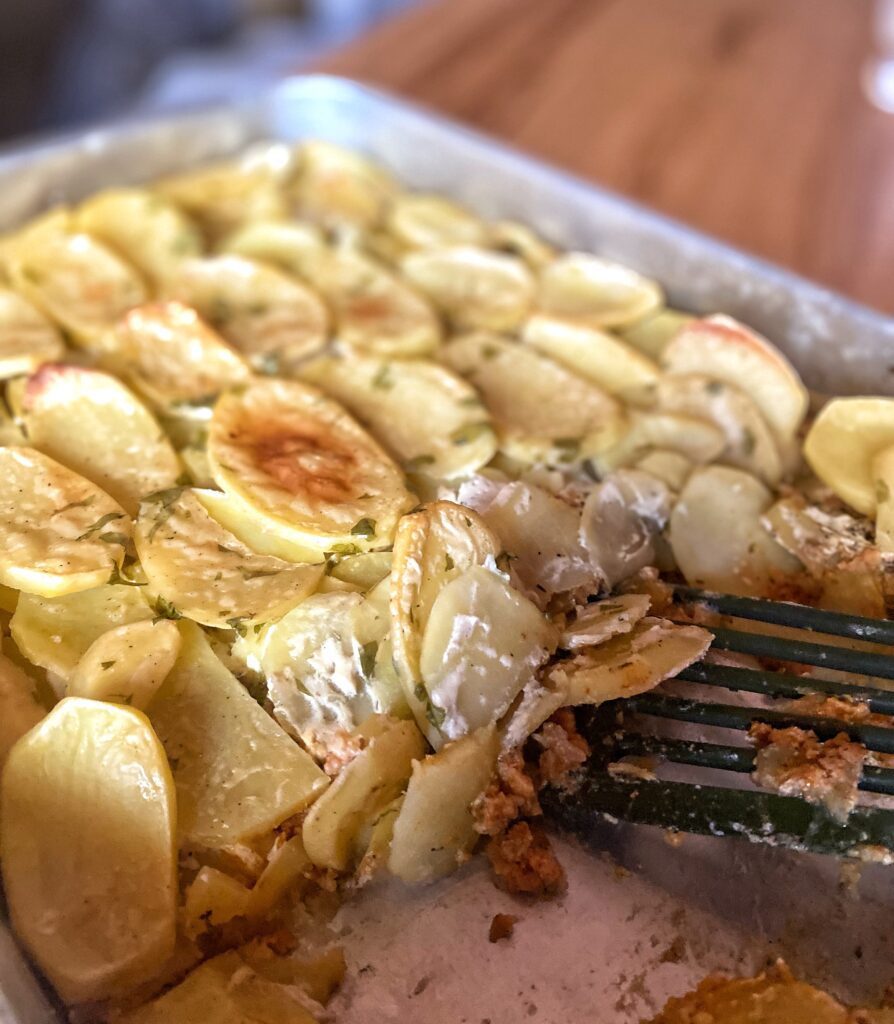
Polenta is another versatile ingredient used extensively in the cuisine of the former Yugoslavia. Made from cornmeal, it can be served creamy or allowed to set and then baked or fried. When prepared with vegetable broth and topped with sautéed mushrooms or a rich tomato sauce, it becomes a satisfying vegan meal.
As we have made several polenta dishes last week, we will rather focus on others here. Check out my Austrian week’s re-creations!
Salads and Side Dishes
Salads are integral to meals in the Balkans, and many are naturally vegan. Šopska salad, for example, typically consists of tomatoes, cucumbers, onions, and often peppers, topped with a generous amount of grated cheese such as feta. To make it vegan, we will make our own feta like cheese topping!
Another very common side dish is called Đuveč rice. What used to be a simple but popular variation of Đuveč, a traditional Balkan vegetable stew made with a variety of seasonal vegetables, often including peppers, tomatoes, and eggplants, simmered in a savory tomato sauce, became more well known than its original. We simply add rice to the stew, which helps absorbing the flavors and creates a hearty, one-pot vegan dish, to make Đuveč rice, which is commonly served as a side dish to Ćevapčići.
Breads and Pastries
Bread is a cornerstone of Yugoslavian cuisine. Besides typically vegan flatbreads such as Lepinja and Somun, a very famous dish called Burek, a mostly meat-based flaky pastry, can naturally be filled with various ingredients. Spinach and potato fillings are common, providing a savory and satisfying option for vegans.
As we have many fellow recreators who already show how to make the best vegan Burek, we will try another similar dish called Gibanica. Gibanica is a traditional pastry from the Balkan region, particularly popular in Serbia, made from layers of thin filo dough filled with a mixture of cheese and eggs. The cheese used is typically a combination of cottage cheese and feta, creating a rich and savory filling. While the classic version is not vegan, it can be adapted with plant-based homemade cream cheese to prepare a perfect vegan Gibanica.
Desserts
While Baklava, a pastry made of layers of filo dough filled with nuts and sweetened with syrup, can be veganized by using plant-based butter or oil, Tufahija, a dessert of poached apples stuffed with walnuts, can be easily prepared without animal products too – we will try this recipe soon this week!
Our first recipe, from Serbia:
Mussaka sa Krompirom
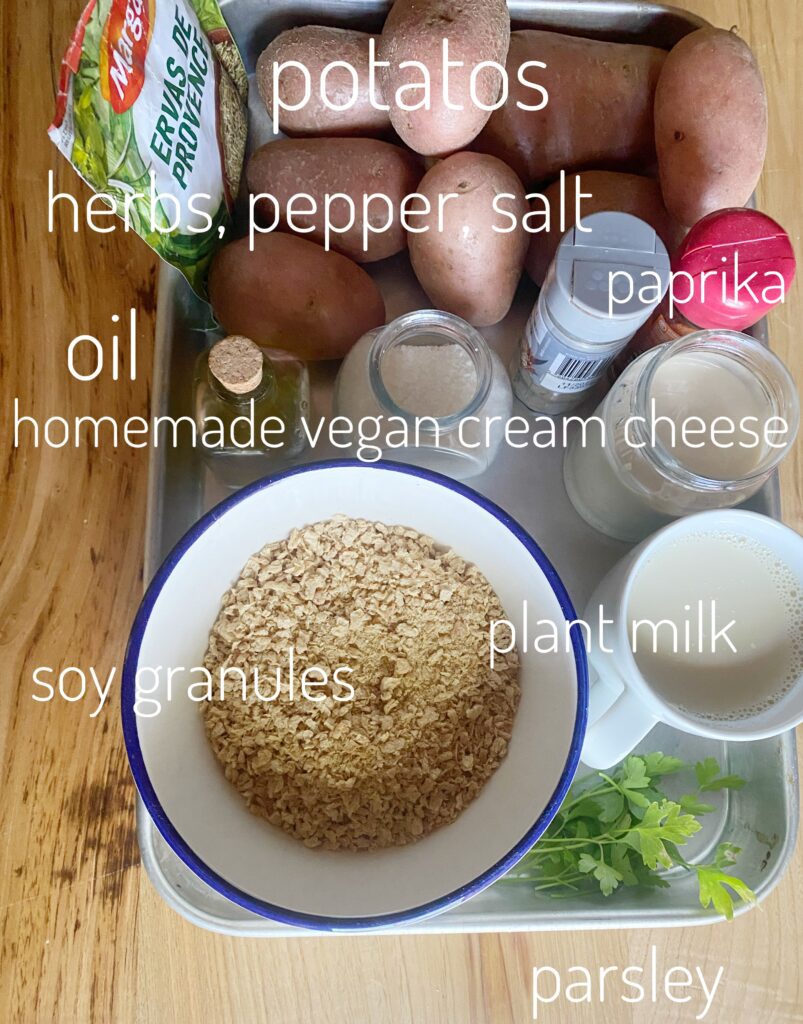
In traditional Serbian cuisine, moussaka features potatoes (Musaka sa Krompirom) as well as a simple topping, such as a mixture of eggs and yogurt or a similar dairy-based mixture, which makes it different from the Greek Moussaka. For a vegan adaptation, we will use our homemade vegan cream cheese and plant-based milk.
While the traditional Serbian moussaka recipe uses only layers of potatoes and meat mixture, in some recipes you can find pieces of tomatoes added to the meat filling. However, I focused on the core ingredients and traditional flavors and therefore omitted any tomato. Feel free to add 2 tomatoes cut in cubes to the soy “meat” mixture.
We enjoyed a fresh Šopska salada with this Mussaka!
Note: As all our dishes, we have been eating our Serbian Mussaka without onion and garlic, as we follow a sattvic diet. No worries, if you feel you need them, I don’t want to stand in their way 😉
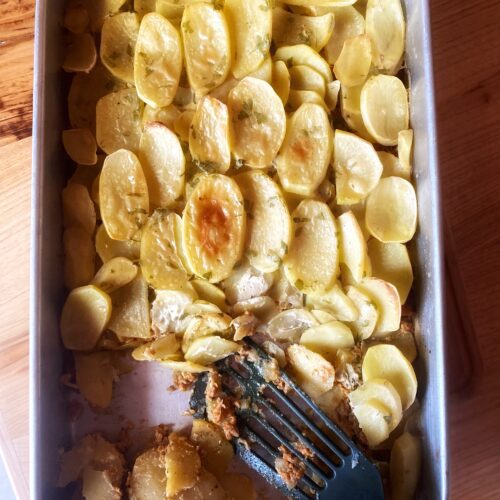
Mussaka sa Krompirom – vegan Serbian potato Mussaka
Equipment
- 1 oven dish (I used a very big one filling at least 6 people’s bellies as this was the only one available… Feel free to choose a smaller one and reduce the ingredients respectively!)
Ingredients
- 200 g soy granules
- 2-3 kg potatoes
- 4 tbsp olive oil
- 3 tbsp tomato paste optional
- 3-5 tbsp paprika powder
- 3 tbsp soy sauce optional
- 3 tbsp dried herbs eg herbes de Provence
- 2 cups homemade vegan cream cheese see notes for the recipe link
- 1,5 – 2 cups plant milk eg soy
- 1 bunch parsley
- salt and pepper
Instructions
- Soak the soy granules in hot water.

- In the meantime, start to peel the potatoes – better sooner than later, since there are a lot to peel and cut…;-)
- Drain the soy granules. Heat the oil in a pot over medium heat. Add the tomato paste, soy granules, paprika and pepper and cook for 5 minutes or until the soy is turning brown. Add the soy sauce and stir. Cook for another minute or two.

- In the meantime, continue to peel the potatoes…Once peeled, cut them in thin slices.

- Preheat your oven to 200°C (390°F).Lightly oil your baking dish. Layer half of the sliced potatoes at the bottom of the dish, overlapping them slightly. Season with pepper, paprika and the dried herbs.

- Spread the vegan meat mixture evenly over the first layer of potatoes.

- Layer the remaining potatoes on top of the meat mixture.
- Chop the parsley.

- In a bowl, mix the homemade vegan cream cheese with the plant-based milk until smooth. Add the parsley. Season with salt and pepper.

- Pour the cream cheese and milk mixture evenly over the top layer of potatoes.

- Cover the baking dish with aluminum foil and bake in the preheated oven for 30 minutes.Remove the foil and bake for an additional 20-25 minutes, or until the potatoes are tender and the top is golden brown.

- Let it cool down a little before serving. Serve with a nice Serbian salad aside.

